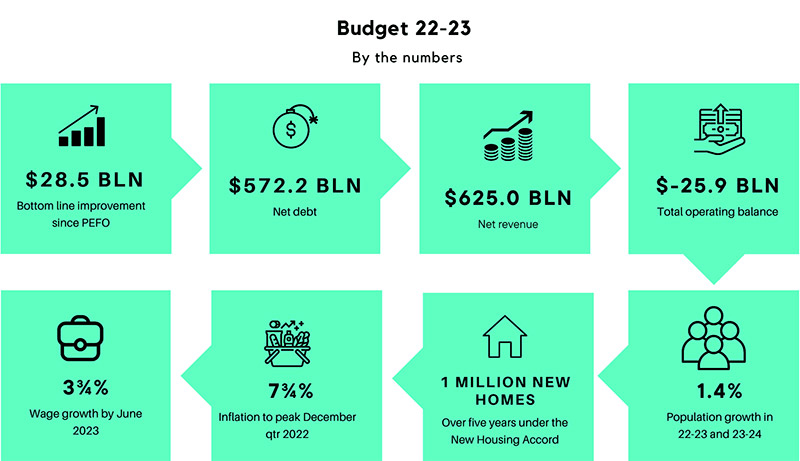One million new homes form centrepiece of Labor's first federal budget
In a federal budget focused on curtailing inflation and helping families with cost of living pressures, Labor 'pulled a rabbit out the hat' in announcing a stunning new ambition to build one million new homes over five years.
The federal Labor Government’s first budget was never going to be a lavish spending spree.
Limited by a post-pandemic record deficit and runaway inflation, the emphasis on government spending necessarily shifted towards targets that would ease cost of living pressures without fuelling further inflationary pressures.
With a rental crisis that has rendered homes difficult to find in the capital cities and hammering the economies of regional centres, affordable housing was a predictable component in what Treasurer Jim Chalmers has sold as a “solid and sensible budget that aims to provide cost-of-living pressure.”
One of the centrepieces of the 2022-23 budget new national Housing Accord that aspires to build one million new, well-located homes over five years from 2024.
The budget set aside $350m in additional federal funding for the construction of 10,000 affordable homes over the five-year period, while state and territory governments have committed to building 10,000 more.
Mr Chalmers said this allocation was on top of the $10 billion Housing Australia Future Fund, promised by Labor before the May election to build 30,000 new social and affordable housing properties in five years.
“Australia is facing acute housing pressures and too many Australians do not have access to affordable housing,” Mr Chalmers said.
“At the same time Australia has a low level of institutional housing investment and the world’s third largest pool of capital in our superannuation system, which is hungry for investments that will deliver stable returns over the long term.”

In its stated aim of “helping more Australian realise their dream of home ownership”, there were a handful of other measures announced, most of which were known election promises.
National Housing Infrastructure Facility: The Government is expanding the remit of the scheme to allow it to more flexibly use $575 million of existing funds. This will help unlock a projected 5,500 new dwellings.
Regional First Home Buyer Guarantee: The Government is helping 10,000 eligible first home buyers a year in regional Australia to buy a home by guaranteeing up to 15 per cent of the purchase price.
Help to Buy: Eligible home buyers will have access to an equity contribution to buy a home with a smaller deposit and a smaller mortgage.
Veterans: The Government is committing $46.2 million to expand the Defence Home Ownership Assistance Scheme. This will support veterans and Australian Defence Force members to purchase a home through monthly subsidies on mortgage interest payments.
Older downsizers: The Government is extending the exemption of home sale proceeds from pension asset testing by 12 months and is expanding access to make downsizer contributions to superannuation for people aged 55 to 59.
Renewables for homes: The Powering Australia plan focuses on bringing cheaper renewable energy to homes and businesses, including $224.3 million Community Batteries for Household program and $102.2 million for Community Solar Banks for 25,000 apartments, rentals and low-income households.
Industry reacts
The inflation and interest rate outlook paints a relatively gloomy near-term outlook for both homeowners and renters, with interest rates set to continue to rise, peaking in 2023 and remaining restrictive into 2024.
Inflation is expected to peak at 7.75 per cent in the December quarter of this year.
Rents are at record highs and vacancy rates at corresponding lows.
So how effective does the real estate sector think the budget will be in turning the tide for housing?
Real Estate Institute of Australia President, Hayden Groves, said improvements to housing and rental affordability will not be realised straight away.
“While this budget was appropriate for the current circumstances both internationally and domestically, the 2023 Budget needs to address how we put some jam on our bread and butter through increased real earnings.
“A serious conversation on tax reform with intent to implement needs to happen,” he said.
Graham Wolfe, Managing Director, Housing Industry Association, said it was imperative that action be taken to ensure housing supply does not fall below 200,000 new homes each year.
HIA’s forecasts show that this situation is playing out right now – with around 196,000 new homes predicted to start in 2022 and 2023, falling to around 185,000 in 2024 and 2025.
“Labor’s first budget shows leadership to tackle Australia’s housing supply and affordability challenges for all Australians,” Mr Wolfe said.
“Year-on-year housing supply shortfalls, as we’ve seen for most of the last two decades, inevitably add pressure to Australia’s housing challenges.
“For every year that Australia doesn’t deliver enough new homes to meet demand across the housing continuum, we will see a negative impact on both housing affordability and rental affordability.”
Build-to-rent housing offers renters ... an additional form of housing that Australia sorely needs.
- Ken Morrison, Chief Executive, Property Council of Australia
The Property Council of Australia described the new Housing Accord as a “rabbit out the hat”.
Ken Morrison, Chief Executive, said the target to create one million “new, well-located” homes over five years from 2024, mostly from the private sector, is at least 100,000 more than otherwise forecast through normal market activity.
“The intention is bold and sorely needed,” Mr Morrison said.
“Enlisting the states and territories in the solution is necessary and welcome but there will need to be more tangible measures overlaid on these plans if the Government’s objectives are to be met.
“Importantly, the Government has commissioned the soon-to-be established National Housing Supply and Affordability Council to review the policy settings for institutional investment into housing, with specific mention of build-to-rent housing.”
Mr Morrison said build-to-rent housing had been overlooked for too long as part of the solution to the housing and rental crises.
“Right now, current tax settings around build-to-rent housing are a barrier to investment, and a levelling of the playing field will bring more rental stock online, as noted by the Productivity Commission last month.
“Build-to-rent housing offers renters greater security in their tenancy, superior facilities and services, and an additional form of housing that Australia sorely needs,” he said.
Investors fleeing
Property Investment Professionals of Australia (PIPA) Chair Nicola McDougall said the budget announced some sound strategies but she still needed to be convinced it could rectify the issues.
“While the aspirational target of one million new affordable dwellings in the five years from 2024 is to be applauded, it must be noted that the Federal Government’s plan only includes its own commitment to actually construct 40,000 social and affordable houses across the nation – a drop in the ocean compared to what is needed.
“According to the Australian Bureau of Statistics, nearly one million dwellings were reportedly constructed in the five years to March this year.
“It is vital that all stakeholders – including private “mum and dad” investors who provide the vast majority of rental accommodation in this country – are considered in any plan to improve the supply of rental housing in this country.
“That’s because 16.7 per cent have sold at least one dwelling in the past two years, which potentially depleted the supply of rental stock nationally by nearly 270,000 or 10 per cent.

Shannon Battisson, President, Australian Institute of Architects
“In a sign of more rental stress for tenants to come, the 2022 PIPA Annual Investor Sentiment survey found that if the 19 per cent of investors who are considering selling in the next 12 months did so, then another 200,000 rental properties could disappear from the rental market around the nation – especially if investment buying activity remains low.
“Tellingly, three of the top four reasons why investors may sell their property over the year ahead is because they fell that they have lost control of their assets.”
The Australian Institute of Architects welcomed the emphasis on sustainable housing.
The Institute’s National President Shannon Battisson said the budget was a “first step”.
“Problems are not just about the numbers of dwellings but dwellings that are overcrowded, costly to run due to low energy efficiency, design that is unresponsive to the needs of people with various disabilities, nor co-designed with residents or communities to create positive and inclusive communities,” Ms Battisson said.
“A decades-long, funded strategy will help to overcome the challenges of housing stress and unaffordability, and ultimately make Australia a better society where everyone has a home. Bipartisan support is necessary to make this happen.
“This strategy needs to be backed up with a solid supply chain strategy to ensure there are resources, materials and skills, to deliver homes to meet demand.”



















